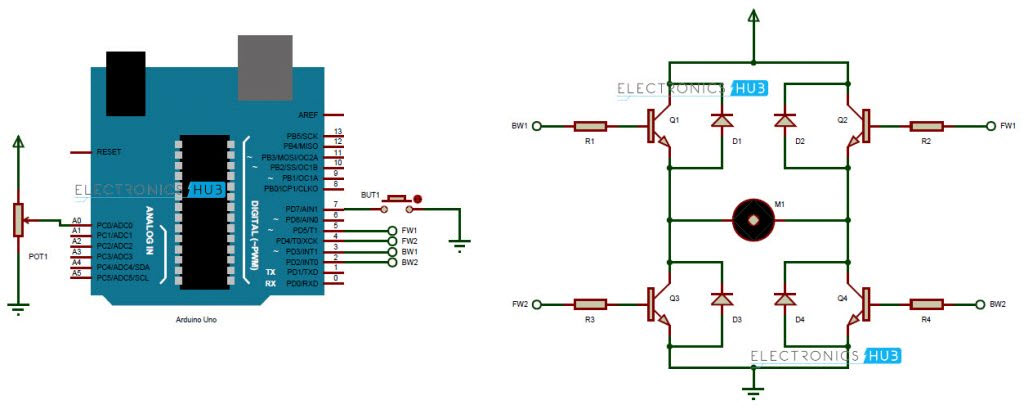

- #Arduino project forward and reverse motor using how to
- #Arduino project forward and reverse motor using driver
- #Arduino project forward and reverse motor using full
- #Arduino project forward and reverse motor using pro
- #Arduino project forward and reverse motor using download
#Arduino project forward and reverse motor using full
In its minimal position the motor should come to a complete stop, and in the maximum position should be at full speed.Ĭontrolling a DC motor (forward and reverse)

If everything is connected correctly you should have complete control of your DC motors speed by turning the pot. * Set the on time of the duty cycle to match the position of the pot. The mapįunction takes this value which could be anywhere between 0 – 1024Īnd reduces it down to match the duty cycle range of 0 – 100 */ * Read the analogue pin to determine the position of the pot. * Set the duty cycle of the PWM signal in 100uS increments. Motor number, the second is the motor type, and the third is theĭigital pin that will control the motor */ * Set the analogue pin the potentiometer will be connected to. Note that it doesn’t have to be a PWM pin – * Set the pin that will control the motor. Step 5) Cut and paste the example sketch below into the Arduino IDE and upload it to your board.
#Arduino project forward and reverse motor using driver
Connect this external power to the driver boards Vin (positive) and GND (0V) terminals. In the above example we are using a standard 130 motor which can be powered from four AA batteries. Use an external power supply or a battery. Even with small motors they can draw enough current to overload it. Don’t be tempted to power your motor from the Arduino’s power supply. It doesn’t matter which way around the motor is connected. In this case to the V+ and V- terminals of the drive board. Step 3) Connect the DC motor to the driver board. Don’t forget to hook up a ground (GND) connection from your Arduino to the driver board. Connect the signal pin from the module to digital pin 7 on the Arduino. Therefore we are using an interface board, which is essentially just a FET brought out to a convenient set of terminals. You should never connect a motor directly to an Arduino’s digital pins as it is very likely that doing so will damage your Arduino. Connect this to the analogue input pin A0 on the Arduino. This will give a value between 0 and 5V depending on the position of the pot. Connect power across the pot by connecting the GND and 5V pins on the Arduino to the outer two pins of the pot (it doesn’t matter which way around they go so long as they are connected to the out pins). Step 1) First of all you will need to connect the potentiometer to one of the Arduino’s analogue pins (A0) so that it can measure the position of the pot. The HCMotor library (see the very bottom of this post for a link). Some wire to connect it all up, such as this. To interface to the motor either a transistor/FET such as this or as in the case of this example our IFT520 module
#Arduino project forward and reverse motor using how to
The tutorial also assumes that you already have the Arduino IDE installed and are familiar with uploading a sketch to an Arduino board (if not check out our guide here ) and that you know how to add a library to it (there is a guide on the Arduino website here ).

However, for this tutorial we will be using a standard Uno.
#Arduino project forward and reverse motor using pro
Also, the tutorial only demonstrates driving one motor but it is possible to drive multiple motors independently using this library.īefore we start it should be noted that the HCMotor library currently only supports ATMega328 based Arduinos which includes the Uno, Nano, and Pro Mini.
#Arduino project forward and reverse motor using download
You can just go straight to the section you are interested in but don’t forget to go to the bottom of the page to get the download link for the library. The tutorial is in three parts, the first is for driving a DC motor, the second for driving a DC motor but in both forward and reverse directions, and finally the third part shows how to control a standard stepper motor. So to compliment the release of our new Arduino motor controller library (HCMotor) we’ve put together this quick tutorial to show you how to take advantage of this library to do just that. Lots of people out there would like to do this but just don’t quite have enough programming knowledge to get an Arduino to do this. One of the questions we commonly get asked is how to go about using an Arduino to control a motor from a potentiometer.


 0 kommentar(er)
0 kommentar(er)
